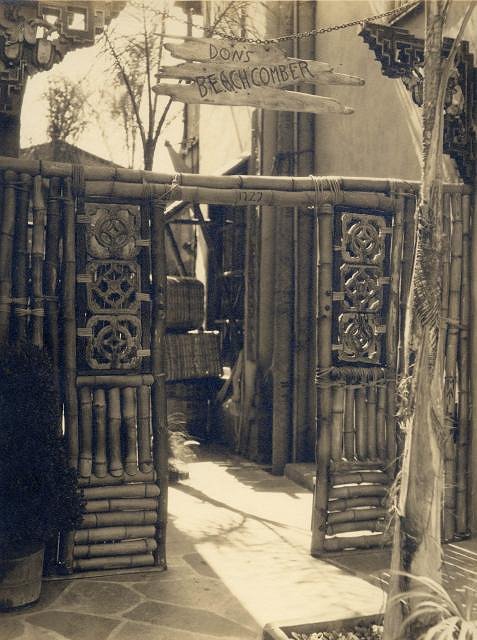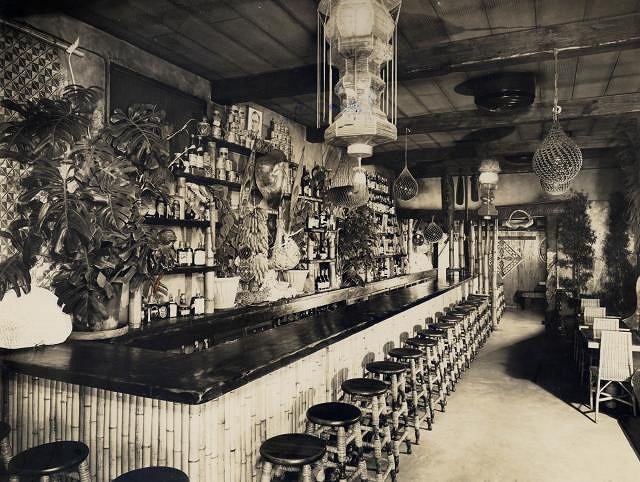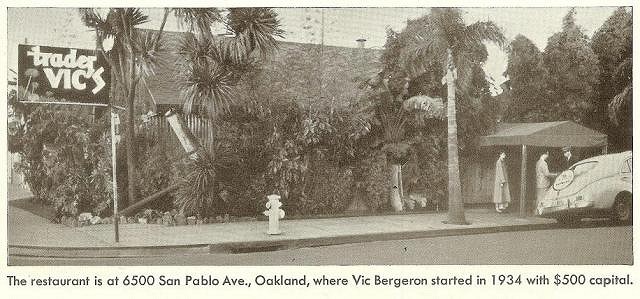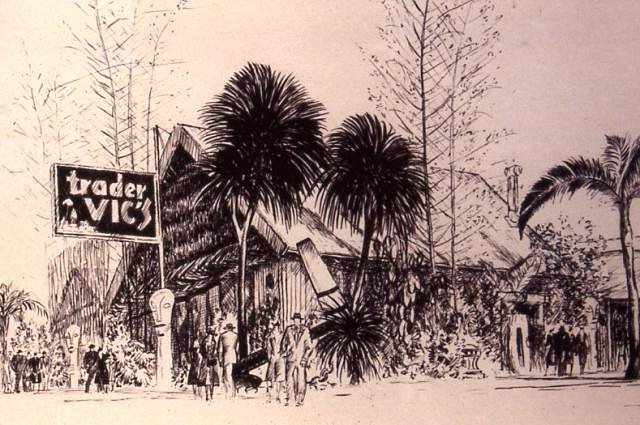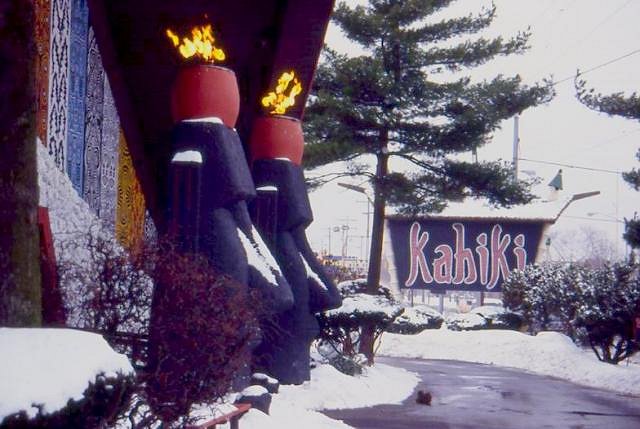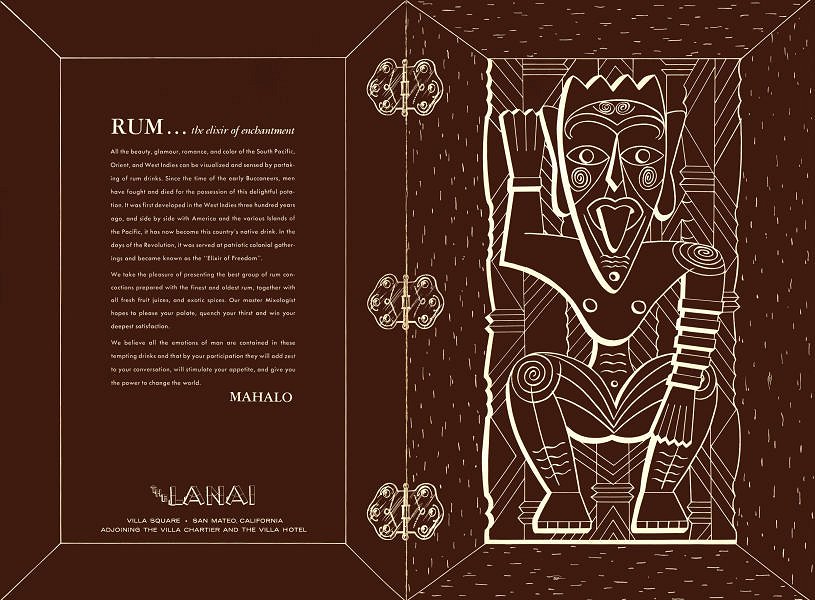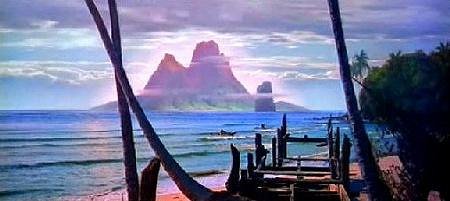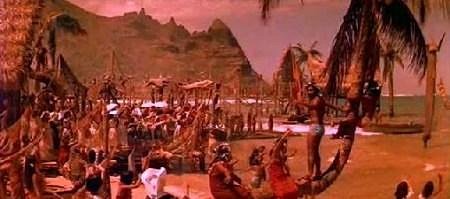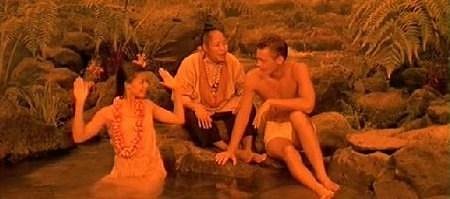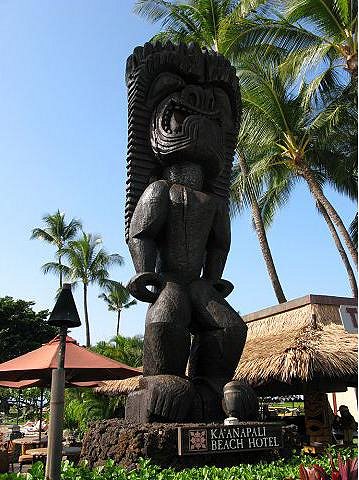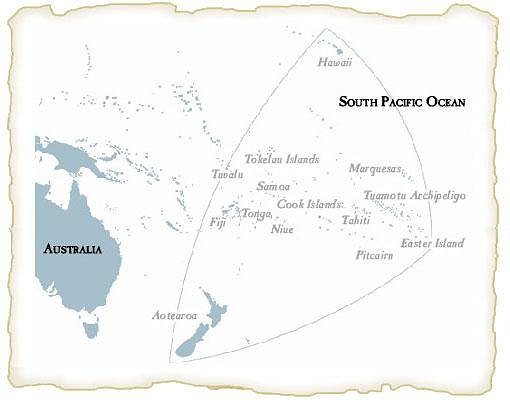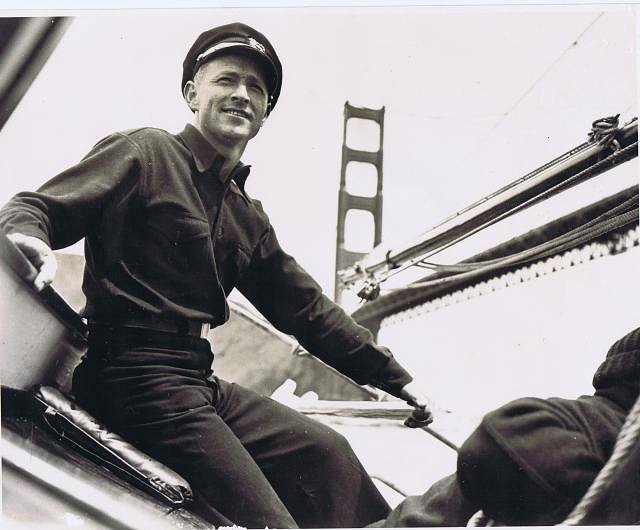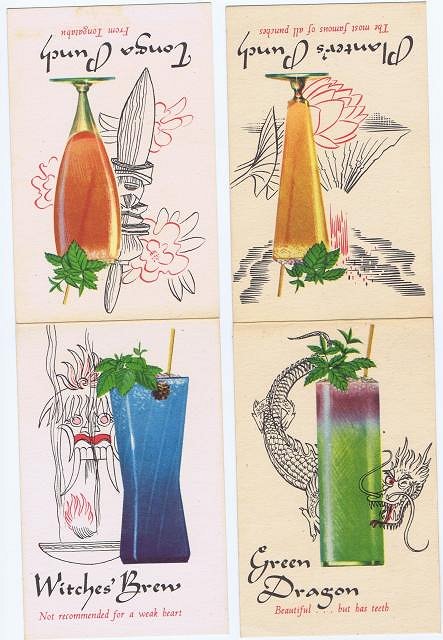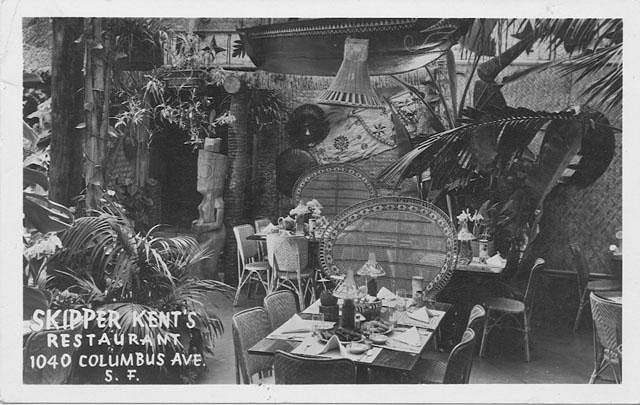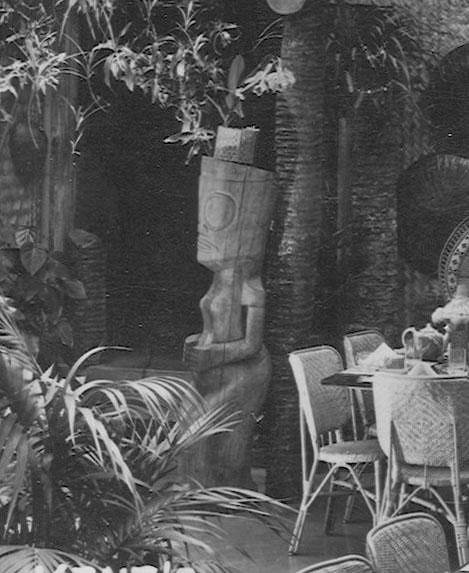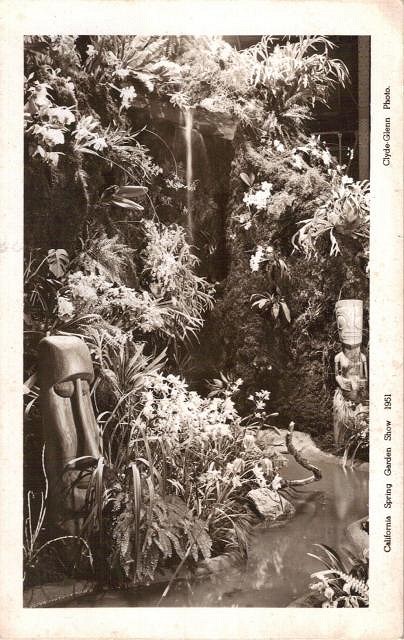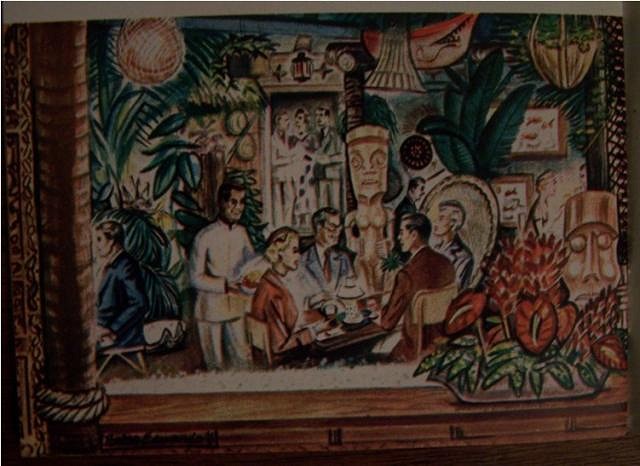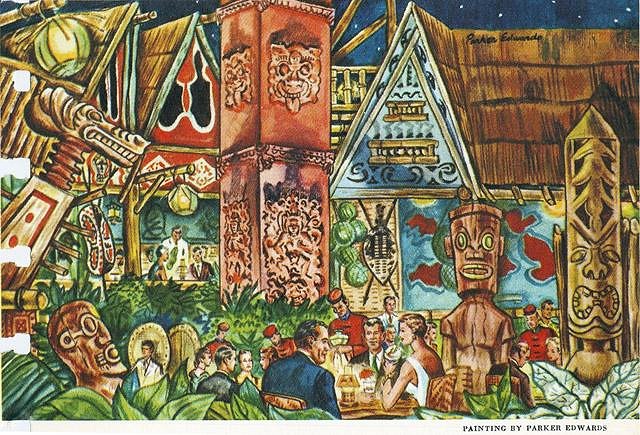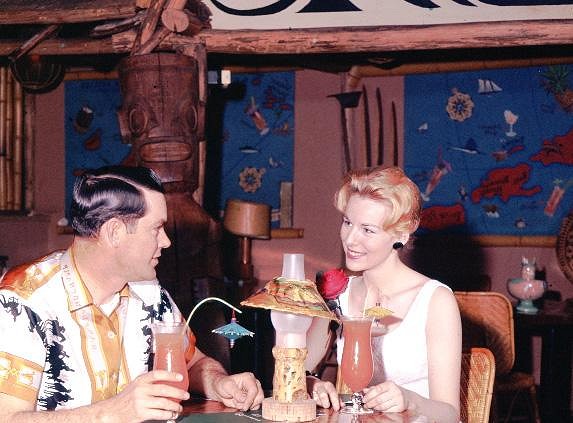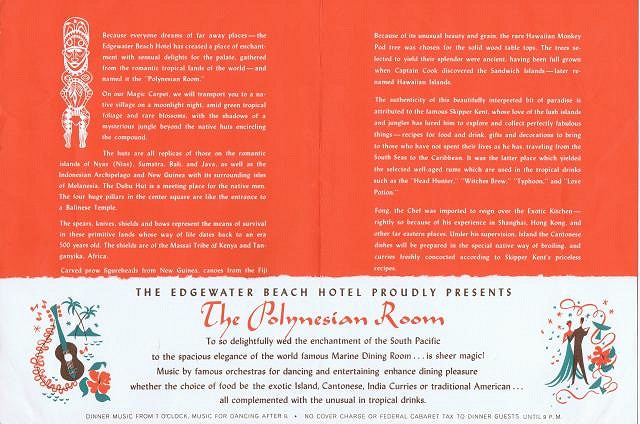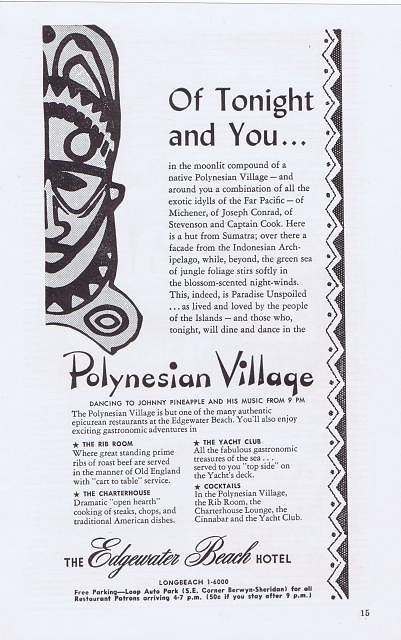Tiki Central / General Tiki
Tiki Culture - Geographical Origins
|
T
TikiShipman
Posted
posted
on
Sun, Jan 23, 2011 9:01 AM
Aloha! Reading James Teitelbaum's book "Tiki Road Trip - A Guide to Tiki Culture in North America", I came across a passage that provoked me to ask you the members some questions about the geographical origins of Tiki culture. James states in his book: In your opinion what is the geographic area that influenced and inspired the Tiki culture? Does the Tiki culture include any parts of Melanesia or Micronesia? For example, would Fiji, American Samoa, Tonga, Tuvalu, Vanuatu, and the Marshall Islands be included? Or is it only Polynesia? That said, would the Cook Islands be included? Love to hear what you think! TikiShipman |
|
M
MadDogMike
Posted
posted
on
Sun, Jan 23, 2011 9:28 AM
"In your opinion what is the geographic area that influenced and inspired the Tiki culture?" California |
|
B
bigbrotiki
Posted
posted
on
Sun, Jan 23, 2011 9:43 AM
Just to elaborate a little, the Tiki culture this site is primarily concerned about is the American re-invention of Polynesian cultures. Though that pop culture was inspired by the islands of the South Seas, it is became a genre in its own right. |
|
K
Kaiwaza
Posted
posted
on
Sun, Jan 23, 2011 1:46 PM
For me, in short, what we call "tiki culture" was inspired by the interest in Hawaii and ALL of the islands in the Pacific, I think, due to World War II (the large number of Americans serving throughout Micronesia, Melanesia, etc), impending Hawaiian statehood, the development of STEREO recording helped as well (I've never heard that mentioned anywhere, but it created alot interest in "ping-pong percussion' "stereo action" and was condusive to strange, exotic recordings). |
|
T
telescopes
Posted
posted
on
Sun, Jan 23, 2011 2:22 PM
So.... in other words.... California. |
|
D
Dustycajun
Posted
posted
on
Sun, Jan 23, 2011 3:30 PM
More specifically, 1722 N. McCadden Place, Hollywood, California.
And 6500 San Pablo Avenue, Oakland, California.
DC |
|
CAA
Chip and Andy
Posted
posted
on
Sun, Jan 23, 2011 6:53 PM
You can't exclude the contributions of the Atlantic and Caribbean..... The rum that makes the drinks so yummy is a result of prohibition driving the drinking crowds down to Cuba and then on to the other Islands. The Nautical theme that runs just under the surface in most fine tiki establishments has its roots in the European Explorers making it into the Pacific to 'discover' the Islands that influenced everything we now call "Tiki.' And then, as to where "Tiki' comes from. It comes from here. And by here, I mean where ever you happen to be while you are imbibing a rum soaked cocktail while imagining yourself 'getting away from it all' and wandering a beach with a topless wahine or kane. |
|
CAA
Chip and Andy
Posted
posted
on
Sun, Jan 23, 2011 6:56 PM
To all of you saying California is the 'source of Tiki'....
suck it! :wink: :wink: |
|
T
TikiShipman
Posted
posted
on
Mon, Jan 24, 2011 7:55 AM
Thanks guys for all of your answers! It's really interesting reading the different thoughts on the subject. You have all helped to make clearer for me, how the inspiration for Tiki evolved. From what I've read, It is indeed an "Americanization" of all of those romantic, mysterious, and paradisiacal images that were experienced or imagined from the South Seas. Even though the American Tiki genre was essentially born in California, those pioneers like Don The Beachcomber did create it out of everything he had seen and experienced when he travelled to many islands, so we can't deny the incredible influence of the Pacific islands. Geographically, it looks to me that inspiration came from all of the islands in the Pacific (Polynesia, Micronesia, and Melanesia), and even though Tiki culture is "faux Polynesian style", creating authentic spaces (as in Tiki bars) and embracing all of the art and culture from these islands really does help to create more of a reality, as if we're really there. I say, go visit all of these places and bring back the real indigenous art to decorate your Tiki bars to help create an even more authentic escape. All of your answers were excellent. Thank you Dusty Cajun for those great vintage photos of Don The Beachcomber's bar. Kalwaza, your answer with the part about the development of stereo sound is an interesting addition to the evolution of Tiki. Chip and Andy, interesting including the Atlantic & The Caribbean; the rum theory does make some sense. You also made me very thirsty, and laugh out loud at your last post, very funny! Feel free to keep the thread going. If you agree with what I'm going on about, great! If not, and you think I've had too much rum and I'm talking out my ying-yang, love to hear your thoughts. Cheers! TikiShipman |
|
S
Swanky
Posted
posted
on
Mon, Jan 24, 2011 9:06 AM
Just in case you are not emmersed in the history and the California answer does not make things clear: Donn Beach opened his place at the end of Prohibition in 1933. He invented what we now call the Tiki bar. He was very soon copied by Victor Bergeron who had opened his place "Hinky Dinks" at the end of Prohibition in 1933. He renamed it "Trader Vic's". He, and many others jumped on the Beachcomber bandwagon. Those 2 eneded up, along with Steve Crane's Kon Tiki's as chains that crossed the US and on around the world. Those were all also copied and became every other place with every other name out there. The Mai-Kai was created by the brothers Bob and Jack Thornton in 1956 after having visited Don the Beachcomber's in Chicago. That same inspiration lead to the Kahiki opening in 1961 in Ohio. The success of the Mai-Kai fanned the flames in Florida as well and may have been the source of a second wave. All of this is owed to Don. And his "Rum Rhapsodies" which created a huge excitement that went round the world. He himself had traveled around the world and his Tahitian and other island trips inspired him. After him, it was greatly inspired by the Oceanic Arts museum catalogs that the makers of things copied. So, Californis is the answer. One man started it all. |
|
JC
Jeff Central
Posted
posted
on
Mon, Jan 24, 2011 9:24 AM
Thanks for mentioning Ohio's contribution to Tiki.....
|
|
J
JOHN-O
Posted
posted
on
Mon, Jan 24, 2011 9:30 AM
But who put the "Tiki" in Tiki culture ?? Wasn't that Stephen Crane ? |
|
B
bigbrotiki
Posted
posted
on
Mon, Jan 24, 2011 10:18 AM
That was Bob Bryant, when he left Trader Vic's IN 1955 and opened "Tiki Bob's" one block down the street from the S.F. Trader Vic's. He used it in the name first, and he shares the credit with Steve Crane AND Trader Vic of using the Tiki as a logo for the first time, which marks the beginning of Tiki culture within Polynesian pop: At the entrance, on the menu, matchbooks, ads, and as a mug or S&P shakers. Mind you, it has not been determined what year the first Tiki mug appeared, it seems likely that the Tiki Bob mug came out later. Trader Vic introduced his Maori logo Tiki on his Beverly Hills "Traders" menu also in 1955. So it really was a Zeitgeist/ synchronicity thing - though Crane is known to have been copying a lot from Vic. I am not sure what year the "Luau" changed from its Pre-Tiki bamboo decor which hailed from when it was "The Tropics" to the more elaborate Tiki decor mentioned in its menu introduction. I never understood this strange competitiveness about the origins of Polynesian pop and Tiki. This is not some kind of sports jock contest, the historic facts are simply that - Facts: Don The Beachcomber inspired Victor Bergeron, Lee Henry and Bill Sapp, and the Thornton brothers. Nobody is gaining anything by that fact, or trying to diminish the importance of the Mai Kai and the other Tiki power places, it's just how it was. |
|
B
bigbrotiki
Posted
posted
on
Mon, Jan 24, 2011 10:20 AM
Ha Boris! Synchro-post! :) |
|
B
bigtikidude
Posted
posted
on
Mon, Jan 24, 2011 10:31 AM
There is no denying that the Mai Kai, Kahiki, and other great tiki temples But.... The over abundance (i.e. in every corner of Cal.) of Tiki/Tropical/Hawaiian- bars, restaurants, hotels, motels, is(WAS) just staggering. I went to a Slack Key Hawaiian music festival in Redondo beach yesterday. Almost to a Obsessive level for some. Jeff(btd) [ Edited by: bigtikidude 2011-01-24 12:20 ] |
|
BB
Bora Boris
Posted
posted
on
Mon, Jan 24, 2011 10:34 AM
Yeah, you got me! :lol: but things do get a little weird with Chinese Food on the menus and Trader Vic claiming to have brought sushi to the United States, I'd say that Steven Crane helped make the Tiki waters cloudy at Ports O’Call in Dallas, where in addition to Papeete he had The Saigon, The Macao and The Singapore Yacht Club dining rooms. I'm sure back then exotic was exotic and that's all that really mattered, it works for me. |
|
M
MadDogMike
Posted
posted
on
Mon, Jan 24, 2011 11:33 AM
To keep the style from growing stale, I think it is important for current tiki artist to continue to get fresh inspiration from authentic artifacts rather than just rehashing the mid-century American interpretation found in todays thrift shops. That's not to say I don't like things that are done in a classic style, but some of the most treasured mugs of years gone by have hideous glaze jobs. But I'm also not against new technology being incorporated into tiki art such as tastefully done LED eyes. No, Stephen Crane didn't use any LEDs but he might have if they were available. |
|
B
bigbrotiki
Posted
posted
on
Mon, Jan 24, 2011 2:20 PM
Mid-century Tiki found in today's thrift shops? Where, where, please tell me! :D Re-hashing mid-century Tiki style does not seem to be as much of a problem nowadays as rehashing Tiki Revival Tiki style. Some new artists are not going any further than what they find on the internet - as in OTHER Tiki artists' work. So the art becomes repetitious and starts going in circles. Indeed, just like with the mid-century artists, Oceanic art books should be part of every Tiki artists creative diet, or their work will turn out thin and flat. [ Edited by: bigbrotiki 2011-01-24 15:50 ] |
|
T
tikiyaki
Posted
posted
on
Mon, Jan 24, 2011 2:44 PM
True dat, but Florida was a serious hotbed of Tiki back in the day....maybe even on par with California....BigBro ? As far as what's still remaining, nothing comes close to the Mai Kai for over the top, original Tiki-ness. |
|
T
TikiShipman
Posted
posted
on
Mon, Jan 24, 2011 3:49 PM
|
|
B
bigbrotiki
Posted
posted
on
Mon, Jan 24, 2011 4:15 PM
When looking at the horn of plenty of esthetic concepts and sculptural styles that native artists employed in Oceania, there is just no reason to again and again repeat the same old toothy frown or grin face Tiki that you see everywhere. That is the opposite of the creative spark that first inspired Picasso and the Moderns, and then American mid-century artists. And here is another reason why Tiki blossomed in California: Mid-century Tiki style was a marriage of the above mentioned Oceanic art forms AND modernism AND cartoons - both of which also really flourished in California at the time! It was a fertile creative ground. And yes, Florida WAS a hotbed of Tiki in the late 50s and early 60s: With the Mai Kai and other places like Tiki Gardens as inspiration, dozens of not only restaurants but also Hotels and Motels utilized the motif. Mo-Eye's newspaper archive research recently unearthed a staggering number of previously unknown establishments, sometimes even with their own carvers. Yet still, measuring by the amount of bars, restaurants, motels, bowling alleys, Luau grounds, and especially the multitude of Tiki apartment complexes, the West Coast and especially Southern California really brought the genre to its fullest expression. The presence of Oceanic Arts and carvers like Leroy Schmaltz, Eli Hedley, Milan Guanko, Barney West, Ed Crissman and all the other guys who worked for O.A. formed a solid artistic force unmatched anywhere else. |
|
J
JOHN-O
Posted
posted
on
Mon, Jan 24, 2011 4:24 PM
The thing about Tiki in (Southern) California is that we have so many other high-profile influences like "Hollywood" and beach culture. The interesting thing to me about Tiki in places like the Midwest, is that it might be Tiki-style in its purest form, i.e. Polynesian iconography COMPLETELY out of its Tropical warm weather native context (unlike So CA and Florida). Pictures of the Kahiki during the winter evoke that for me (I think the Bigbro took this picture)...
Does anyone go just to make a pilgrimage at the Walgreens ?? [ Edited by: JOHN-O 2011-01-24 16:26 ] |
|
B
bigbrotiki
Posted
posted
on
Mon, Jan 24, 2011 4:39 PM
About the Mai Kai, and in favor of its importance to the birth of Tiki style: Though the Thornton Brothers did admit to have been inspired by Don's Chicago Beachcomber, and many of the concepts and elements of Polynesian pop they and the others used were first employed by Don, they really upped their forefather in the Tiki esthetic: While all of Don's "children" made the transition around the mid- to late 50s into using Tiki as the predominant decor and design icon, Don himself stuck to his "Beachcomber" style and had very little Tiki art on his trademark items. I had mentioned the fact in the BOT that IF Don can be said to have had a logo Tiki, it was his pet Tahitian Cannibal Carvings. It is a curious fact that the Thorntons, of all of Don's "students", picked up on that and more than anybody else utilized the Cannibal Carvings for their purposes - taking the one Tiki item used by their "ancestor" to greater prominence, proving that they were tuned in to the Tiki Zeitgeist of the times, while Don remained "Old school". Stephen Crane's designer Florian Gabriel once noted that Polynesian style was just growing "tired" when Tiki came around and imbued it with a fresh spirit. |
|
A
aquarj
Posted
posted
on
Tue, Jan 25, 2011 12:24 PM
Interesting to see the answers here. At the risk of getting all analytical and stuff (and maybe repetitive too), my take was that there's probably a range of different questions suggested by the topic:
Maybe the question was mostly about #2, especially since #1 and #3 would never apply without something as an original inspiration. Very true that much of the work by the earliest poly-pop practitioners was inspired by the consumption of authentic polynesian and oceanic artifacts in books. But as others have pointed out, it very soon evolved to a situation where the inspirations were more strongly linked to the prior works of poly-pop artisans than to authentic oceanic forms. It really is surprising when you get down to it, that it was such a small handful of carvers and artists who started and ran the stylistic movement (the names bigbro listed, plus a few more). And their influence went everywhere, from California, to Florida (like the Mai Kai tiki by Californian Barney West in the posts above), to Hawaii and even further abroad. And while Donn Beach was the undeniable originator of the poly-pop phenomenon, its spread took on a life of its own. As a practical matter, places like the Mai Kai or Kahiki would trigger a localized domino effect where other nearby venues would be more influenced by these places than by other sources in California or elsewhere. And as others commented, the presence of tikis themselves was an adaptation that differed from what you would find in an actual Don the Beachcomber location. BTW, about the first tiki used as a logo in a restaurant, I've been curious lately if the Lanai in San Mateo might have been earlier than Tiki Bob's. The Lanai opened in 1950, and they had that weird logo tiki on their doors and menu in the 50s, but I don't know if it was all the way back in 1950. Speaking of inspirations, I don't know where the heck this is supposed to be from - kind of seems like a weird hybrid.
Back to the question regarding ORIGINAL sources, in those kinds of conversations I like to suggest the mythical location of Bali Hai. Not the restaurant in San Diego, I mean the place that Michener conjured up in Tales of the South Pacific. Maybe partially because of the actual fact of the influence that mythical place had on popular culture, when it appeared in print and even more so on the stage and screen. But even more than that, the concept of Bali Hai is kind of the perfect metaphor as a place that represents the mishmash of real and fantasy embodied in tiki culture. It's a good way of conveying the un-authentic-ness, without getting into the endless exceptions and counterexamples of trying to list real geographic sources.
-Randy |
|
B
bigbrotiki
Posted
posted
on
Tue, Jan 25, 2011 1:27 PM
I know what you are saying, Randy, the spirit of all the South Sea cliches that surround Tiki is certainly strong in "Bali Hai" (as I noted in my "Sound of Tiki" CD). But something cannot be the originator of something if there is nothing of it in it. Tiki style is totally unique in its character because it is a pop culture that originated in the restaurant industry. Film and other popular genres might have played a part, but bowling alleys and apartment buildings modeled themselves after the Tiki eateries (and drinkeries). I always view the American Bali Hai/South Pacific fever (the song, the musical) as forming the fertile soil that Tiki grew out of. But also the peak of that form of super-schmalzy South Seas kitsch. Considering what COULD have been in the movie, it has very few, almost NO Tikis in it. It is the pinnacle of Poly-pop, but not Tiki. Tiki really happened when primitive art appreciation caught on. What inspired me to look into it was the juxtaposition of 50s modern man with pagan idols. A 50s "South Pacific" image without a Tiki just wouldn't have grabbed my attention. |
|
A
aquarj
Posted
posted
on
Tue, Jan 25, 2011 1:54 PM
Yeah, that's true - not much tiki on Bali Hai, just as there wasn't much tiki in the earliest Don the Beachcomber. So, I totally agree with what you're saying here. Just as Donn Beach was the originator of most trappings of the cultural movement that later spawned more tiki stuff in its evolution, I guess I'd see a parallel in something like a mythical Bali Hai concept that inspired and stoked (but didn't originate) the poly-pop style that became tiki culture. -Randy |
|
BBS
Beach Bum Scott
Posted
posted
on
Tue, Jan 25, 2011 3:45 PM
While we can have endless discussions about where Poly Pop Tiki started/grew from, what is left out and never talked about is the people that caused Tiki to grow. Not the Dons, Vics or Cranes of Tiki but the Joes and Janes that went to the Tiki palaces. They were the ones seeking that Bali Hai... Make a Mai Tai and pick up a Ukulele!!! [ Edited by: Beach Bum Scott 2011-01-25 15:50 ] |
|
B
bigbrotiki
Posted
posted
on
Wed, Jan 26, 2011 12:15 PM
Very true. That's why Tiki style was never recognized in its heyday, it was an unconscious by-product of a general escapism. But that is part of what makes it so fascinating, and such a discovery: In the course of people just having fun, an art form was born. They just didn't know it back then All my above posts (like a large percentage of my TC post in general), deal with Tiki as an ART FORM ( or design style), not primarily the lifestyle that was connected with it. The art form and the lifestyle were inexorably connected, yes, but they are not one and the same. |
|
BBS
Beach Bum Scott
Posted
posted
on
Wed, Jan 26, 2011 12:59 PM
Thanks For this Bigbro this clears up alot for me about your postings. So on that train of thought would that make the Mai Kai in its self a work of art or a museum that houses works of tiki art? hmmmm... Things to ponder... Make a Mai Tai and pick up a Ukulele!!! [ Edited by: Beach Bum Scott 2011-01-26 13:04 ] |
|
B
bigbrotiki
Posted
posted
on
Wed, Jan 26, 2011 1:46 PM
Absolutely! As the most complete, un-changed example of its style, it should become a national landmark - but still be kept open and functioning! :D |
|
C
christiki295
Posted
posted
on
Wed, Jan 26, 2011 4:14 PM
Ironically, now various places have adopted the Tiki style, such as the Hawaiian Hut (RIP) and Tiki's in Waikiki. |
|
C
christiki295
Posted
posted
on
Wed, Jan 26, 2011 4:29 PM
A bigger example of Tiki being used as pop culture decor is in Maui at the Ka'anapali Beach Hotel:
[ Edited by: christiki295 2011-01-26 16:29 ] |
|
BBS
Beach Bum Scott
Posted
posted
on
Thu, Jan 27, 2011 10:26 AM
|
|
CAA
Chip and Andy
Posted
posted
on
Thu, Jan 27, 2011 9:02 PM
|
|
J
jpmartdog
Posted
posted
on
Fri, Jan 28, 2011 5:28 AM
Interesting conversation- Thanks for all the great posts! Wish my family and friends could understand the depth and history behind my "tiki" friends and passion! |
|
I
IslandSpy
Posted
posted
on
Tue, Feb 1, 2011 5:00 PM
Does Indonesia count as a part of Tiki inspiration? It is part of geographical Oceania, but not political Oceania. They have the same origins as Polynesians. |
|
M
MadDogMike
Posted
posted
on
Tue, Feb 1, 2011 5:07 PM
I think most people here will feel that Indonesia is not included in Polynesia. While there are some similarities, the art of Indonesia is more closely identified with India than Polynesia. Plus, Indonesia gets low marks for being the source of the cheap tikis that are flooding the US - available at Pier One, Home Depot, and Big!Lots :D |
|
I
IslandSpy
Posted
posted
on
Tue, Feb 1, 2011 5:21 PM
This is true not so much the style of the art, but some of the subjects of the teak panels. My fiance lived in Indonesia for 8 years and acquired a lot of carved teak furniture. It has a very, very island/ tiki feel with the tropical plants, taro patties, peacocks, plumerias and coconut trees. But some of the carvings have Hindu imagery (like Rama & Sita in exile), which is where the Indian religious influence comes in. The islanders there have little connection to the animism of their ancestors (although the same could be said for the rest of the S. pacific, where they're mostly Christianized as demonstrated by the churches on every corner in Hawaii, lol). Does this mean I can't hang out at Tiki Central??:( |
|
M
MadDogMike
Posted
posted
on
Tue, Feb 1, 2011 6:32 PM
:lol: No, you're still welcome here. Eventually you will develop good taste in tikis :lol: |
|
K
Kaiwaza
Posted
posted
on
Wed, Feb 2, 2011 2:47 AM
Well, for my part..Indonesia and The Philippines are part of Oceania (The Malay Archipelago can be included in Oceania by most definitions) and their artwork, in my mind, is absolutely part of contemporary tiki culture. I mean, if nothing else, the very fact that 80% of everything in the International Marketplace is from Indonesia & The Philippines ought to account for something! :) |
|
W
Wayfarer
Posted
posted
on
Sat, Feb 12, 2011 6:41 AM
I think the Philippines has some claim to tiki- after reading Beachbum Berry I get the impression that without Filipino bartenders tropical drinks would be up the Sh-- Straits without a paddle. I've transited those straits by the way, we get hazardous duty pay for it. |
|
BB
Bora Boris
Posted
posted
on
Sat, Feb 12, 2011 8:15 AM
This is where it gets weird Wayfarer - Filipino Bartenders and Filipino Carvers (in the United States) are good but imported mass produced Philippine carvings are not good and while the Philippines are in the South Pacific and (Some citizens) consider themselves to be Pacific Islanders I guess they're too far west of New Guinea to be considered part of Polynesia. :o Thanks for bringing this up I've been curious about if for a while but I wanted to start it with "So let me get this straight..Filipino bartenders and Filipino Carvers are cool but anything else from the Philippines is bad? and what's with New Guinea? Old Guinea must've really sucked if you'd want to start over in that place!" :lol: |
|
J
JOHN-O
Posted
posted
on
Sat, Feb 12, 2011 8:59 AM
Let's not confuse the ethnicity of significant mid-century Tiki contributors with giving credit to the country of their actual or implied origin. Would a BMW be Tiki based upon the contributions of revival pioneers like the Bigbro and those with Germanic surnames (like Von Stroheim) ?? |
|
BK
Big Kahuna
Posted
posted
on
Sat, Feb 12, 2011 9:06 AM
Ouch!
|
|
M
MadDogMike
Posted
posted
on
Sun, Feb 13, 2011 4:31 PM
This seems like a good place to interject that I appreciate the fact that Tiki Culture values creativity as much or more than "authenticity". I have a friend who is a Civil War Re-enactor where authenticity is everything and creativity is not welcomed! |
|
NB
nature boy
Posted
posted
on
Sun, Feb 27, 2011 2:59 PM
In case anyone is unsure what is ihncluded in Polynesia here is a handy map of the Polysensian triangle.
[ Edited by: nature boy 2011-02-27 15:00 ] |
|
C
christiki295
Posted
posted
on
Fri, Apr 22, 2011 7:46 AM
Its gotta be the weather which is why Cali & Florida took to it so well. |
|
STCB

Sabu The Coconut Boy
Posted
posted
on
Fri, Apr 22, 2011 3:54 PM
Speaking of the progenitors of "Tiki" in California, the name of Frank "Skipper" Kent needs to be added to the pantheon. In fact I would place him in the top three with Don The Beachcomber & Trader Vic. The more I research his history, the more I see how influential he was in the movment.
Like Donn Beach, Frank Kent was also a world traveller - sailing extensively thoughout Polynesia, the East Indies, and the Caribbean in the 1930s, collecting artifacts, plants, & rum. All these elements will go towards the ambience of his future restaurants. In 1938 he settles down briefly in Berkeley and opens a cocktail bar called the "Skipper". It is here, we assume that he begins to experiment in tropical cocktails, because by 1942, when he opens the Zombie Village in Oakland, the drinks on his vast cocktail menu are credited as his own creations. This must be taken with a grain of salt, of course, as there was probably much cross-pollination of drink recipes between Frank Kent, Donn Beach, and Victor Bergeron, though his documented history of rum-collecting travels in the Caribbean lend credence to at least some of his claims. His Zombie Village drink, the "Tabu" is said to have contained 7 different types of rum and was served in a glass vessel of beautiful design. Though no tikis have been spotted in the numerous photos and drawings of the interior of the Zombie Village, it is said he had a shrunken head on display as well as a carved "tabu" grave marker dating from the 17th century that he collected on a south sea island. He was using "tiki-ish" Indonesian and Tongan iconogrophy on his 1940s drink cards:
In 1950, Frank Kent opens a sister-restaurant; "Skipper Kent's" in San Francisco. It is here that the tiki first takes it's place as part of the south-seas decor of his restaurants. This card is postmarked 1953, but the image probably dates from 1950-1951:
Frank Kent was also a horticulturist and built greenhouses in Walnut Creek where he grew the tropical plants for his restaurants from specimens he had collected on his travels. In 1951, according to an issue of Orchid Digest he donated a large quantity orchids (as well as some decor) to the 1951 Spring Garden Show in Oakland. Here is a postcard, showing his display tikis, perhaps the earliest introduction of a moai as part of poly-pop decor:
In this Feb 1953 issue of "Ford Times", both the Marquesan tiki and the Moai again show up as part of the decor at Skipper Kent's.
...and when he opened the Polynesian Village in Chicago, in 1955, the use of tikis was carried over to this location as well:
In this location he also used decor from Java, Bali, Sumatra, Indonesia, as well as Melanesia and New Guinea (he had first sailed there and collected artifacts way back in 1944). Thus, he was also among the first to use New Guinea iconography on his menus:
So while Bob Bryant is credited with first using a Tiki as a logo and as part of a restaurant name in 1955 for "Tiki Bob's", it could be argued that perhaps Frank Kent introduced the tiki as restaurant decor. Fascinating too how Skipper Kent was plying his trade cheek-and-jowl with Trader Vic in the bay area during the same time period: 1934 - Victor Bergeron opens his sandwich shop, "Hinky Dink's" in Oakland at 6500 San Pablo Ave.
[ Edited by: Sabu The Coconut Boy 2011-04-22 16:37 ] |

